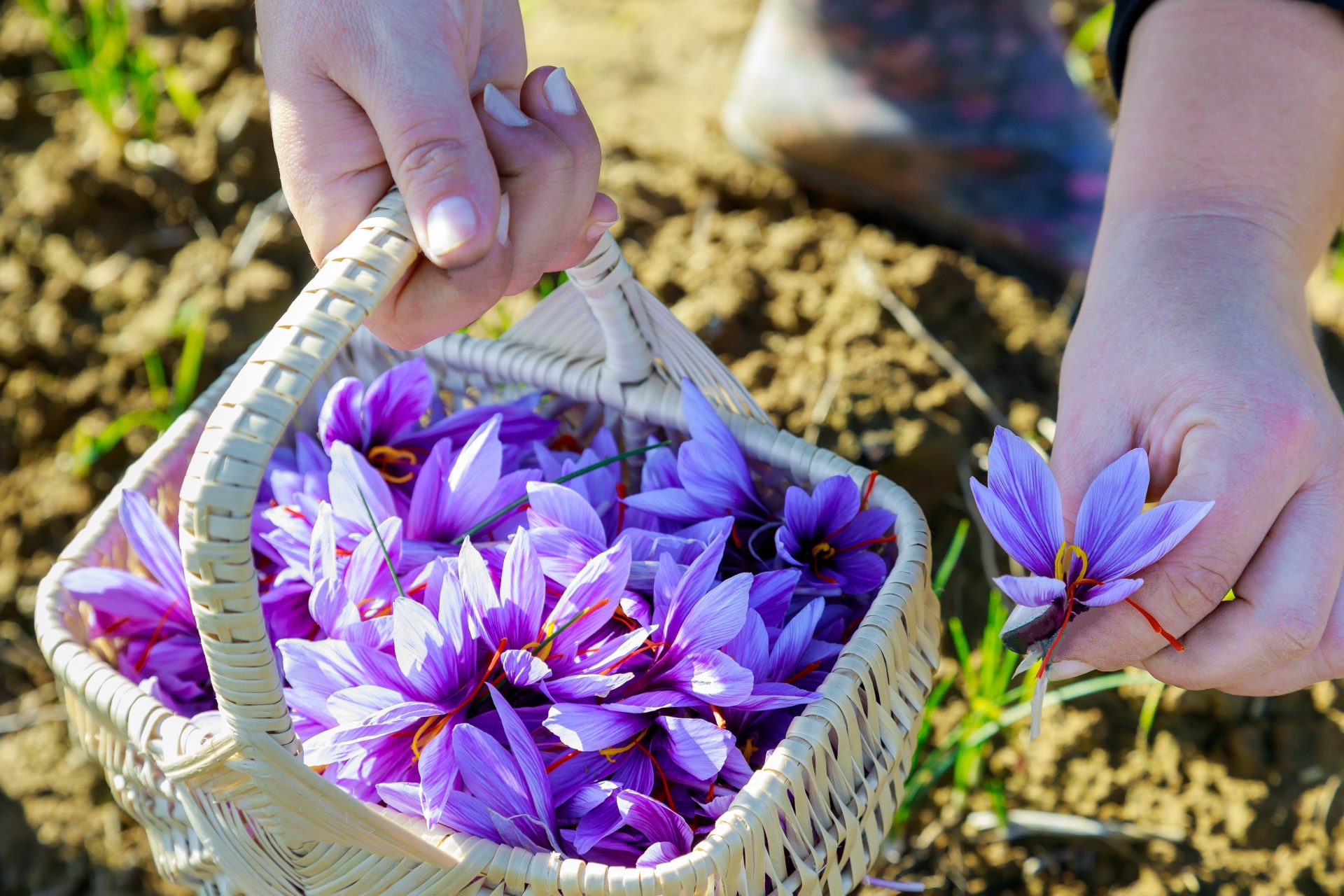Harvesting saffron is a little bit of an art, but once you learn how harvest saffron correctly, it is well worth it. Saffron harvest season is very short and happens in the cooler months, which makes timing very important. By following saffron picking tips, you will be able to catch those flowers at their most tender, snipping the red-colored stigmas with care and saving all that flavor and color. Whether as a hobby or your intended saffron business, we go over all that needs to be done from flower to spice—let us get started!
What is Saffron and Why is it so Valuable?
Saffron is thought to be the most valuable spice in the world due to its bright golden color, strong fragrance, and characteristic flavor. Well, here goes: it is hard to believe, but saffron actually comes from a flower! It’s not some magical ingredient that grows on trees or something created in a lab. The saffron is harvested from the red stigmas of the Crocus sativus flower; actually, thousands of flowers produce just one pound of this spice. This is the main reason it’s so pricey.
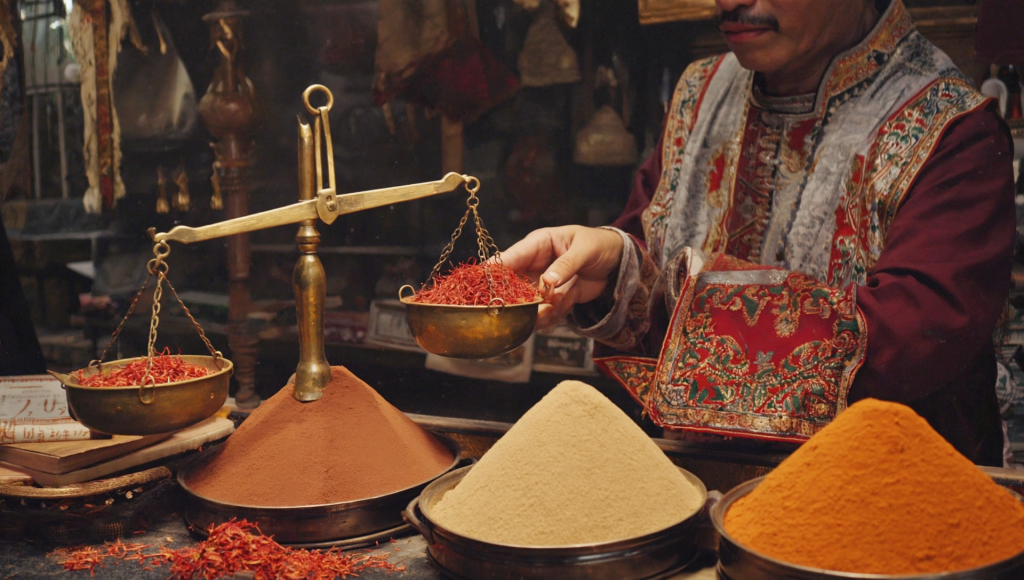
Now, for those curious as to how harvest saffron, well, it’s a real labor of love. There is a really short saffron harvest period, which occurs in autumn, at the end of October/November when these plants blossom. You’ll just need to get them at exactly the right moment before plucking the pretty, little, fragile-looking red stigmas from under their caps—that’s no easy task, of course.
So, why is saffron so pricey? Because it’s ridiculously labor-intensive to gather, and its flavor and color are simply next to none. Each and every thread of this spice is just packed with flavor that will make any meal special—whether it’s a creamy bowl of risotto or a steaming pot of tea.
In other words, due to its rarity, the tedium of picking it by hand, and also due to certain peculiarities related to the spice itself, saffron is placed at such great value.
How and When to Harvest Saffron?
What is the time when saffron reaches its finest? It comes down to only one thing—timing. In other words, you want those flowers at exactly the right stage, and in most cases, this is during fall—that is, the time when saffron is harvested. Most areas enter the beginning phase of saffron when it is around 8 degrees Celsius or 46 degrees Fahrenheit—which is hot enough to bring the first week of November through to December in most parts of the world.
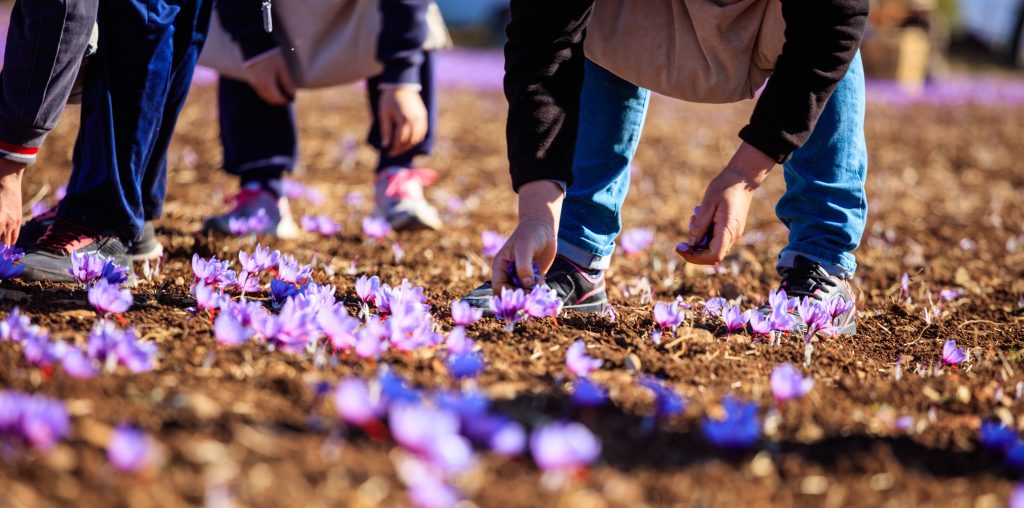
Now, the flowers do not last long, about 1-3 days, so you have a small window for picking them in their best phase. You see, you will want to pick when the flowers have been in bloom for 7 – 10 days; that’s when they’re at their prime, full of color and flavor. Miss this window, and the flowers go south very fast.
Here’s a giant Saffron picking tip for you: do your picking during the early mornings! That is the perfect time for getting to the flowers before the sun pokes its head out and starts frying the color and fragrance out of the blooms. What’s more is that the air in the mornings is cool; hence, you keep them fresh. Get there early to assure you get the best of the best.
How Do You Determine Ready-to-Harvest Saffron Flowers?
Knowing when flowers are ready to be picked up is just not about picking any flowers. It requires only that much amount of patience and observation of time. The thing is that saffron flowers bloom one by one, generally between November and December. The art of gathering saffron falls in place with the opening of flowers. One has got to be on one’s toes during this period! The most appropriate time when one recognizes a saffron flower which is ready to be harvested is due to the condition of the bud before it has completely opened. One catches it early in the morning, better before sunrise, when the buds are still closed. This is the time when the best quality saffron with good aroma and color can be procured.
Regarding the saffron picking tips, don’t just pluck any flower. Gently take the head of the bud, then pull it out of the soil. If you wait too long and the flowers open, it becomes much harder to pluck, and some of that precious quality you’re holding gets lost.
Watch those flowers closely then, and be ready when they bloom-just before opening is when you’ll want to harvest.
What Are the Best Techniques for Picking Saffron Stigmas?
There are a couple of different ways you can pluck saffron stigmas depending on how you plan to process the threads. If you’re wondering how to effectively harvest saffron, here are some of the best methods to keep in mind:

The Bunch Method: This is one of the most common ways to separate saffron. You start by gently pulling out the three red-branched stigmas from the flower. Once you have them, spread them out on a table to dry. It’s a simple process, but it requires careful handling to avoid damaging those delicate threads.
The Sargol Method: This method involves cutting the stigmas at the point where they connect to the pistil, collecting them, and then separating them. If you’re aiming for higher-quality saffron, this is often referred to as “Sargol”. It’s a bit more meticulous but gives you a cleaner product.
The Pushal Method: Here, you’ll need to separate not only the saffron stigmas but also any remaining parts of the pistil that might be attached. This method involves a bit more work, but the result is high-quality saffron that’s perfect for premium culinary uses.
The Negin Method: This involves plucking the saffron branches straight, without bending them. In this way, one will avoid plucking any portion of the pistil. This will result in thread saffron, which is very beautiful and even in color, perfect for those who enjoy their saffron pristine.
So, when you are right in the middle of the saffron harvest season, remember some of these techniques to make sure that you are getting the best quality possible. Among the saffron picking tips that one should bear in mind are never to hurry, try to handle these fragile stigmas with care, and make sure that they are well-dried after being picked.
How Should Saffron Be Dried to Preserve Its Quality?
Since you’ve found out how harvest saffron, the next big step to be taken is to dry it properly so as not to destroy that costly flavor and color. Saffron is really finicky, as far as heat, light, and water are concerned; thus, proper drying out is just about the most important way to preserve its freshness and potency. Here are 9 different ways in which you can dry your saffron:
Traditional Drying Method: The old-school way is to separate the saffron threads from the petals to begin with. Remember, no washing! Set the threads aside, laying them on a clean cloth with paper towels placed over them. Let it dry in a cool, dry place for about 4 to 7 days. Remember, too much heat causes molding; hence, keep it chill and controlled.
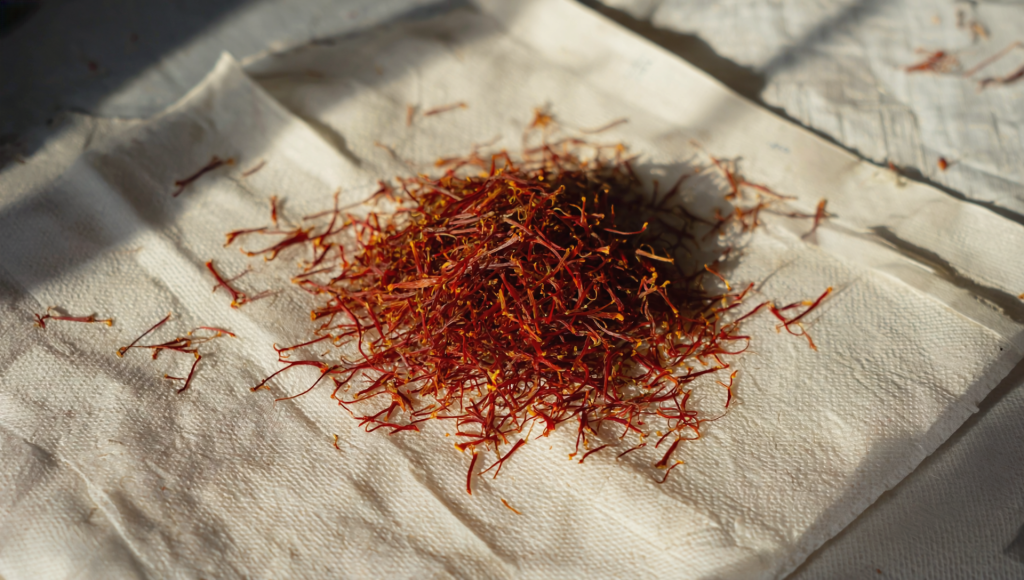
Heater Method (The Easy Way): If you want something quick and easy, take some A4 paper and set up your heater. Put the saffron on the paper with your heater on the lowest setting, and then just wait a day. This is very easy and efficient and gets the job done without much hassle.
Ironing Method: If you are going to use saffron and want it to be nice and smooth, try this ironing method. Just place it between two metal plates or a cotton cloth, then press gently with an iron. This will flatten and smoothen out the saffron for it to look professional and uniform.
Oven Method: This is primarily used when one has an oven. The way to dry saffron petals is by laying them out in a baking tray. Put the oven at some low temperature of about 100°F or thereabouts and let them dry for about 15 to 20 minutes. Again, just make sure you have it checked, for you would not want it too hot, or you will spoil your saffron.
Microwave Method: A very quick method of drying this delicate plant of saffron-microwave it. Quick, energy-efficient, gets the work without burning too much or tiring out the saffron. Just be aware of the fact that you do it in short seconds, lest it overheat.
Electric Dryer Method: It works quite well in an electric dryer if one already is in the habit of drying vegetables and fruits. Only keep the temperature low so that burning of saffron does not take place. Does the job very fast, yet keeps your saffron quality intact.
Spanish Drying Method: It is quite neat, literally speaking! Place your saffron on a sieve and then put it near the heat source. Switch on the fan or air conditioner in its slow speed so that the air keeps on circulating and doesn’t allow any mold to develop. This method is effective both on small and large scales.
Freeze-Drying Method: If you have the relevant equipment for freeze-drying, then it is one option you would consider. Freeze it between -18 to -22°C in roughly 20 hours, then lower the pressure to dry it. It is a bit high tech, but good results are obtained, showing bright color and freshness.
Solar Dryers: If people with an industrial mindset were to do the job, then solar dryers can be another task. The sun’s energy is tapped through a number of layers by these dryers, making these dryers energy-friendly as well. Though quite impractical at home, this is ideal for a large operation.
The important thing is, no matter which method you pursue, it should avoid excessive heat and moisture, as well as overheating. You want your saffron to dry really slow and even for it to retain all of its amazing flavor and color. Follow these, and you shall have top quality ready for use in your cookery!
Common Mistakes to Avoid During Saffron Harvesting
It’s very important to be gentle with this spice during harvesting. Everything can go terribly wrong if you are being negligent. Probably one of the most popular errors to make in saffron harvesting is exposing flowers to harsh conditions. You would be surprised how easily saffron could be damaged when you are not watching for a couple of easy things.
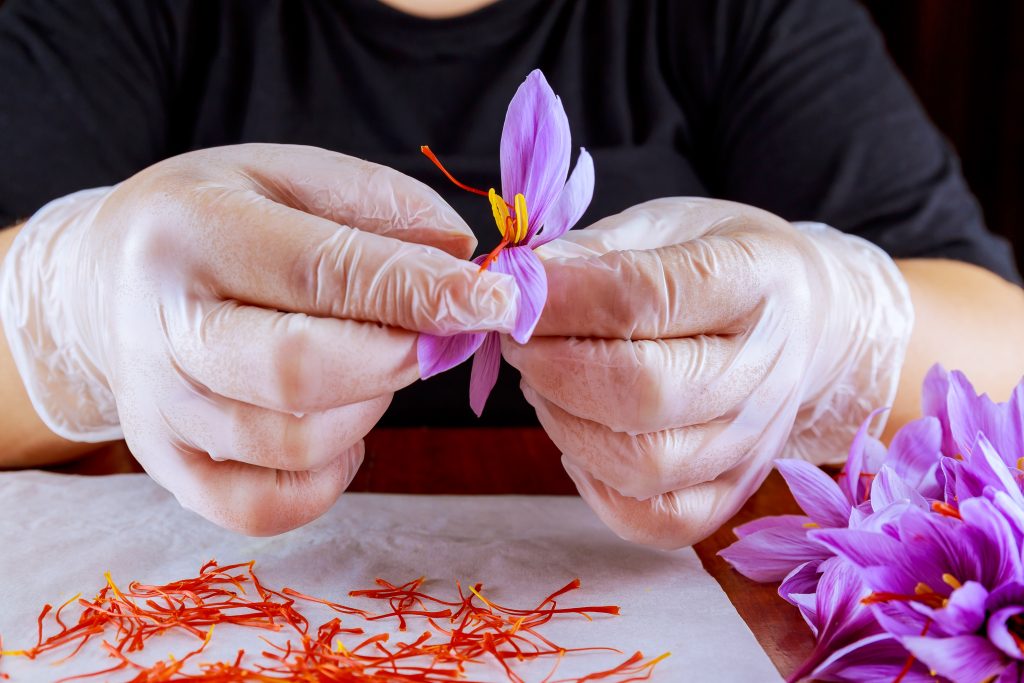
To begin with, you should not harvest the saffron flowers in direct sunlight. Too much light will make the saffron lose its rich color and-most importantly-the distinctive aroma. When trying to work out how harvest saffron, it has to be remembered that the flowers must be picked very early in the morning before the sun gets too strong.
But in place of water, there is excessive heat capable of doing serious damage. It can dry out if it gets too hot, something that will really reduce the quality of the threads, so in case of cooler times of the day, most especially during the saffron harvest season where temperatures are capable of scaling through being managed, the best thing is to harvest at such times.
Other mistakes include wetting the saffron stigmas. It’s very tempting to wash your hands or flowers, but the moisture encourages mold, and that’s a huge no-no for saffron. Avoid liquid contact on the delicate threads at all costs by sticking to dry hands.
Finally, it is bad exposure to air. If you have harvested the saffron, do not leave it with open air for extended periods because it may lose freshness and flavor, factors that are capable of dictating its value. Therefore, immediately after you have carefully picked those red stigmas, store them in a sealed container away from the elements.
By avoiding these common mistakes, you will ensure your saffron stays fresh and full of flavor, waiting for you to use it in all your cooking or selling.
Conclusion: Turning Flowers into Gold
Saffron harvesting is really a sensitive affair that requires patience, precision, and lots of love. From timing your picks during the saffron harvest season to mastering the delicate art of separating those precious stigmas, every step plays a role in the creation of the world’s most luxurious spice. With proper techniques, attention to detail, and a few savvy saffron-picking tips, you’ll preserve the vibrant color, aroma, and flavor that make this spice extra special.
No matter whether for personal use or business, time and effort invested in learning how harvest saffron will pay dividends when it comes to the quality of your end product. Happy harvesting!
If you are interested to know more about saffron and the effects it has on your emotional wellness, go through the following link: Saffron For Emotional Wellness

